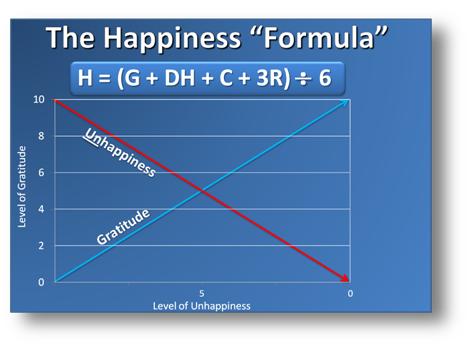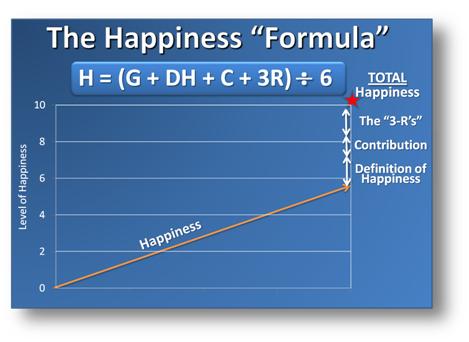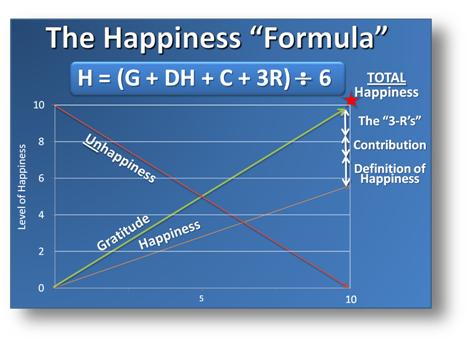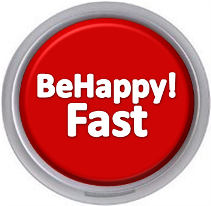The Happiness Formula
There is a "mathematical formula" for happiness. A
"Happiness Formula", or happiness "equation" that can help anyone be
happier.
Yes, you can live a happier life – a much happier life – if you know this formula, understand it, and use it.
The formula is:
H = (G + DH + C + 3R) ÷ 6
Now, for those of you who are not mathematically inclined, don’t worry,
it’s not complicated. In fact, it’s actually quite simple. Simple to understand, but not necessarily easy to implement fully. If it was, then everyone would be totally happy.

NOTE: If you prefer to "watch" this formula in action rather than read about it, get my free 5-Part "Happiness Formula" Video Course by clicking here to learn more about it, or just fill in the boxes to the right to download the course now. Otherwise, keep reading below...
So, here’s the question for you to answer … are you as happy as you can be?
That’s
a very important question. Have you answered it for yourself? If so,
what was the answer? If you’re like most people, the answer is “no” ...
you could be happier (and really want to be happier). And that
doesn’t mean you are unhappy (although many people are). It just means
you could be happier – and would like to be happier – even a little bit.
If
you are like many people, you may not have even taken the time or
effort to ask that question of yourself... but you probably know the
answer anyway.
If you are not as happy as you could be in your
life, for the vast majority of people, there are discrete reasons – and,
importantly – something that can be done about it.
Yes, total happiness can be achieved. And, you can achieve it by using “The Happiness Formula”. Again, the formula is
H = (G + DH + C + 3R) ÷ 6
And again, don't worry, it's not as confusing as it may seem at first. Here’s what it means...
Happiness (“H”) is equal to your level of Gratitude (“G”) ... plus the degree to which you are living consistent with your own personal Definition of Happiness (“DH”) ... plus how much you Contribute to others ("C") ... plus your success in what I call the 3 R’s of happiness (“3R”) ... all divided by 6.
By
using this simple formula, you can determine how happy you are in your
life at any time (your “Happiness Score”), and then create a plan to
improve it. Let’s look at it more closely.
First, let's look at
it from a "big picture" perspective. Total Happiness comes by both
eliminating unhappiness and increasing happiness. Those may sound a bit
similar, but they can actually be very different. First, eliminating
unhappiness. There is an inverse relationship between gratitude (the
first component of our "Happiness Formula") and unhappiness ... as seen
in this graph:

As you can see, as gratitude increases from 0 (lower left corner) towards 10 (upper right corner), unhappiness goes from a 10 (upper left corner) to a 0 (lower right corner). Practically speaking, the more grateful you are for the things you have in your life right now - or at any moment in time - the less you will be unhappy. But, that's only one piece of the equation. You can be very grateful (therefore have very little unhappiness), but still not be totally happy. You might be somewhat content and fulfilled, but maybe not totally happy. That's where the next component of the equation comes in ... increasing happiness, as seen in this graph:

In this graph, you can see that you can increase
happiness from "0" (lower left), but if you are like most people, you
really don't know what would make you happy - and are not doing some of
the things everyone needs to address to be completely happy. In
fact, without the rest of the formula (which we'll get to next), most
people can only reach a level of happiness of around "6" without the
other components. So, before we put all this together, let's explore
the rest of the formula, and get your own personal "Happiness Score" (in
other words, how happy you really are right now). Here's how to do it:
Each of the components of the equation (G, DH, C, and 3R) have a value
level of between "1" and "10". To get your "Happiness Score" (which is
essentially your overall level of happiness) just rate each of the
components of the equation on a “1” to “10” scale, where "1" is
essentially very poor or non-existent (couldn’t be worse), and "10" is
perfect (couldn’t be better or higher)
When you finish applying
the formula, the result will be your “happiness score” which will range
from “1” to “10” (the commonly used “10-point scale”). The closer your
score is to “10”, the happier you are.
So, let’s get started. Take out a piece of paper and a pen or pencil (or tablet, smartphone, or other digital device).
Now...
First:
Using the “1” to “10” scale, rate how grateful you feel on a regular basis
for the things you have in your life right now. It’s important to rate
your gratitude level on a regular basis, not just when you’re feeling
great about something.
Do you live with a constant – and conscious –
feeling of gratitude? Do you focus consistently and consciously on the
positive things in your life?
If so, you may be in the “8” to “10”
range. On the other end of the spectrum, do you focus mostly on the
negative circumstances facing you? Do you usually feel stressed, “down”
or depressed because of everything that's missing from your life - or
just not going right? If so, maybe you are somewhere between a “3” and a
“5” on the 10-point scale. Write down the number you come up with for
how grateful you feel. Alright, do you have it? If so, next...
Next:
Have you created your own personal Definition of Happiness? Most people haven’t, and if you are one of those people, then do it now. You can find out what really makes you happy (create your personal Definition of Happiness) very easily by just getting my Definition of Happiness Creator. Just click on the "Get Instant Access" button in the box below and you'll get it now, along with two FREE ebooks, BeHappy! at Work and A Guide to Healthy Living...
If you don't know your Definition of Happiness, while you're waiting to create it using the Definition of Happiness Creator, for now just write down a “5” for this part.
|
You can also read a “Definition of Happiness primer” to learn a bit more right now about your Definition of Happiness by clicking here if you want to get a bit more insight. The complete process is also found in the first couple of chapters of BeHappy! (so if you really want to figure out your true Definition of Happiness, click here to get your own autographed copy FREE). Again, though, you can find out exactly what would truly make you happiest in life - and create your personal Definition of Happiness - by getting my "Definition of Happiness Creator" by clicking on the "Get Instant Access" button in the box on the right (and get two free ebooks you can download immediately, too). |
  |
Now, if you have created your own Definition of Happiness, use the 1-10 scale to rate how consistent you are living that definition. Here’s what I mean ... If, for example, your definition of happiness includes a certain level of financial abundance, the need for a particular type of intimate relationship, and a specific job or career, and you are not at that financial level, don’t have that relationship, and/or aren’t in that job or career, then you may be between a level “2” and “6”. If, however, with that same Definition of Happiness, you have achieved a certain level of wealth, are in a great, fulfilling relationship, and have a job you love, then you might be somewhere between a “7” and a “10”. There’s much, much more to this whole Definition of Happiness issue, so if you are like most people, you really need to get deeper into it, and create your true definition. For now, though, write down your best "guess" as to what number from 1-10 you are living consistent with "what happiness means to you". Make sure to write down the number.
So now you have two numbers between 1 and 10 - one for your level of Gratitude (the “G” in the formula) and one for how consistent you are living your Definition of Happiness (the “DH”). Next ...
- How much do you Contribute to others on a regular basis? And, this doesn’t only refer to money. This could be your time, emotional support, or physical efforts. Do you volunteer at an orphanage or hospital? Do you donate to a certain charity or cause? Are you there for your friends and family when they need you? Write down the degree to which you are “a contributor” to others, again on that 1-10 scale. If you contribute consistently (daily or weekly) and significantly (a large amount of time, money, or effort), then maybe you are in the 8-10 range. If you don’t contribute much or contribute often, then maybe you are in the 3-5 range. Maybe you’re somewhere in between – or maybe you don’t contribute at all (in which case you would be a “1” or “2”). Write down your number (you now have 3 numbers between 1 and 10). Then ...
- There is the “3R” component. If you have spent time on the BeHappy!journey, you may know that there are 3 foundational life “realities” which have a direct effect on our happiness. These 3 “realities” are Relationships, Rules, and Regrets (the “3 Rs”). I can’t get into each of these in detail in this article, but you can explore each of these areas for yourself in separate areas of the BeHappy101.com site. Again, though, there is also a whole chapter devoted to each of these in my foundational book, BeHappy!, which you can get by clicking here. For right now, the objective is just to get your “happiness score”. So, for this part, similar to the other parts, just use the same 1-10 scale and rate – separately... First, the quality of your relationships (give it a 1-10 score where “1” means your relationships are absolutely terrible or non-existent and “10” means they couldn’t be better);Second, the degree to which you have rules in your life that create conflict and stress. Here, the higher the number (the closer to “10”), the fewer rules you have (which is good) and the less stress and conflict you experience with other people because you don’t have lots of strict rules. If, to the contrary, you have many strict rules about how things must be (which is generally not good), and this causes conflict with many people (which rules inherently do), then you would give yourself a low number, like maybe between 2 and 5. So put down your number. And if you don’t really know (or don’t yet understand this “rules” concept enough) just put down a “5” for now; Finally, the level of regret you feel in your life must be rated. Regrets, especially major regrets, can destroy - or at least reduce - your level of happiness. And this can be regret for things you have done (like stealing, doing drugs, or cheating on your spouse) or regret for things you haven’t done (like not going to college, not pursing your passion as a career, or never having children). Here, again, the higher the score, the fewer regrets you have in your life (which is obviously good). At the extreme, if you have “no regrets” in your life, you would give yourself a “10”; but if you have many regrets – and it’s “eating” at you, then you might give yourself a “1”, “2”, or “3”.
At this point, if you have done everything so far, you should have 6 numbers between 1 and 10 written down on a piece of paper. Once you have those 6 numbers, it’s time to calculate your “Happiness Score”. And now it’s really quite simple.
To get your score, just add up the numbers for each of the 6 components of the process above. You should have a 1-10 score for each of (1) “G”, for gratitude, (2) “DH”, for Definition of Happiness, (3) “C”, for Contribution, (4) “R”, for Relationships, (5) “R”, for Rules, and (6) “R”, for Regrets. Once you have all 6 of these numbers, add them together. The result should be a number between 6 and 60.
Now, take that sum and divide by 6. So, for example, let's say your six numbers were a "7" for Gratitude, "5" for Definition of Happiness, "8" for Contribution, "6" for Relationships, "3" for Rules, and "6" for Regrets, then your "Happiness Score" would be:
7 + 5 + 8 + 6 + 3 + 6 = 35, which when divided by 6 = 5.83.
If this was your score, I would bet you are not very happy in your life – and you want to be happier. Also, even if your score came out to an "8.83", which is not bad, maybe you still want to be happier.
So calculate your own "Happiness Score". This is the first step in a positive, progressive journey toward living your happiest possible life.
Using this “Happiness Formula” allows you to:
- Evaluate your current level of happiness (which you just did)
- Identify the specific areas of your life you need to focus on to be as happy as possible (which you can figure out quite easily by looking at the individual scores which made up your overall score)
- Design a plan to create lifelong happiness
- Monitor your happiness whenever you want (or feel you need to) and then...
- “Tweak” the necessary components of your life whenever you need to in order to keep you as happy as you can be
Putting the whole thing together graphically looks like this:

Looking at this, you can see that if you eliminate unhappiness
completely by being totally grateful for everything in your life (a "10"
on Gratitude) and can increase happiness by getting up to a "10" on your Definition of Happiness, your level of Contribution and the 3 R's of life, you would be "totally happy".
To take the next step in this process toward your happiest possible life, get my FREE Happiness Formula Video Course by filling in the information in the boxes at the top right of this page or click here and I’ll help you personally get to the next step.
BeHappy!my friends
PLEASE CONSIDER...
If the information on this site helps you and you'd like to make a donation to BeHappy101.com (to help make others happy), please click on the button below to make a contribution. The amount you donate is entirely up to you. A portion will used to contribute to the happiness of others and is greatly appreciated. [WHY DONATE?] |







 I'm Jimmy, the founder and creator of this site and the whole BeHappy! system. My life's purpose is to be a positive, creative force for health and happiness and through this website, my books, coaching, and happiness-building programs, I intend to help as many people as possible live their happiest possible lives.
I'm Jimmy, the founder and creator of this site and the whole BeHappy! system. My life's purpose is to be a positive, creative force for health and happiness and through this website, my books, coaching, and happiness-building programs, I intend to help as many people as possible live their happiest possible lives.